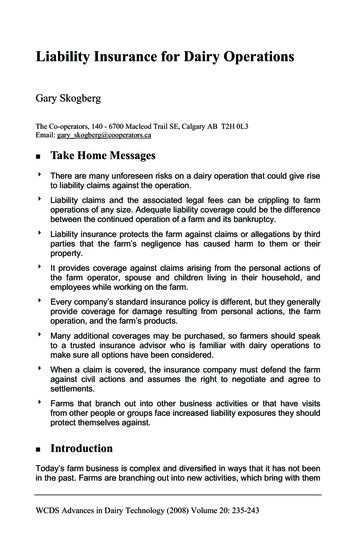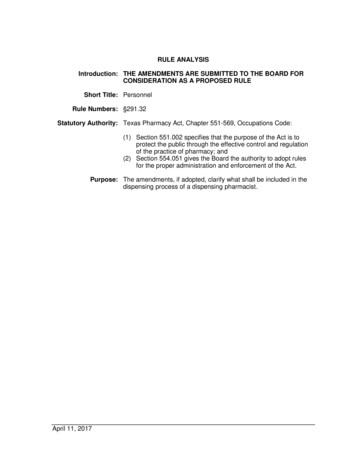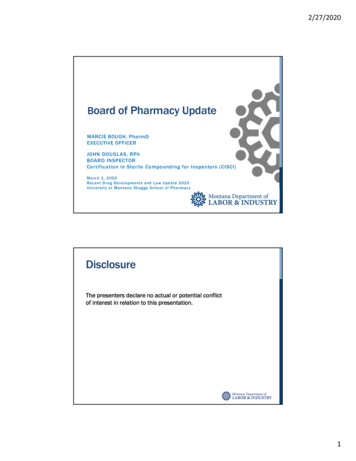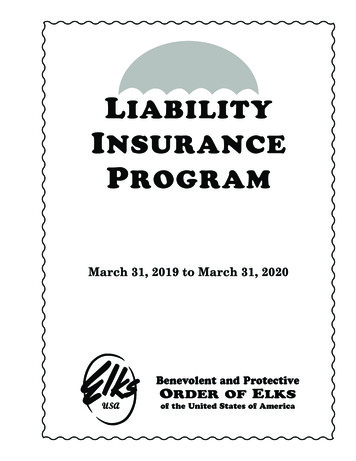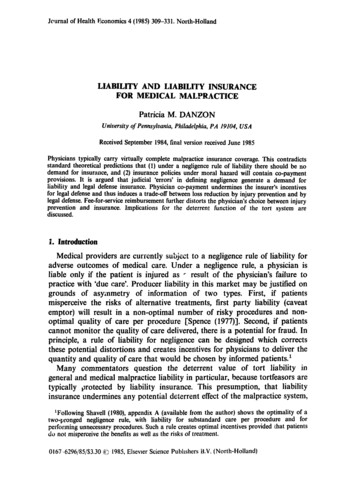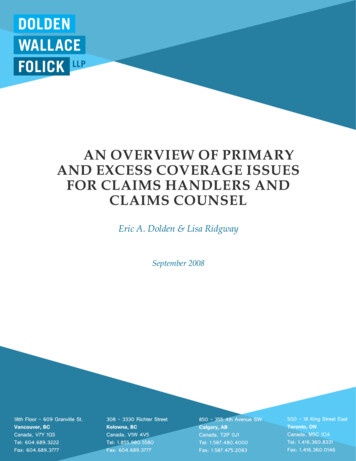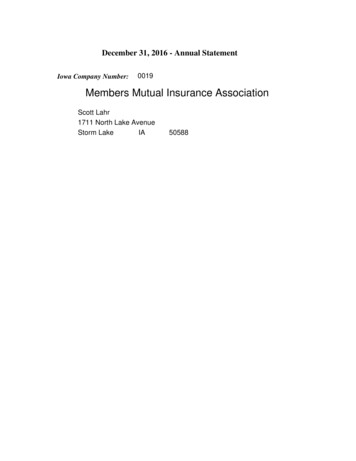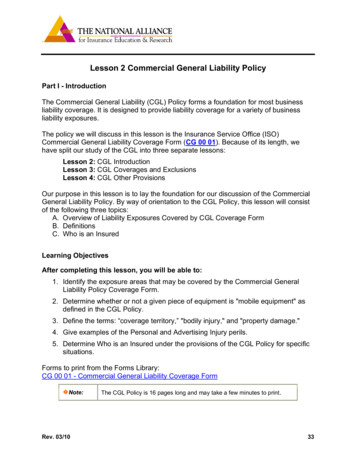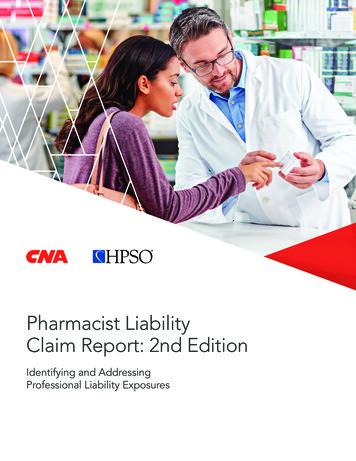
Transcription
Pharmacist LiabilityClaim Report: 2nd EditionIdentifying and AddressingProfessional Liability Exposures
The American Pharmacists Association (APhA) is proud to support the Pharmacist LiabilityClaim Report: 2nd Edition. APhA’s contribution to the Report exhibits our commitment to theadvancement of pharmacists’ patient care activities that result in positive outcomes for patientsand enhanced well-being for pharmacists. We thank CNA and Healthcare Providers ServiceOrganization (HPSO) for their work, and believe this report will assist our members in enhancingtheir patient safety practices for optimal health and well-being of the pharmacy team.Thomas E. Menighan, BPharm, MBA, ScD (Hon)Executive Vice President & CEO, American Pharmacists AssociationThe Institute for Safe Medication Practices (ISMP) is pleased to have provided input into thedevelopment of the Pharmacist Liability Claim Report: 2nd Edition. ISMP’s commitment toadvancing medication safety means we recognize how essential collaboration within the healthcarecommunity is for error prevention. Our collaboration with Healthcare Providers Service Organization(HPSO) provides valuable medication safety content designed to help healthcare professionalsfollow safe medication practices and keep patients safe. We thank HPSO for their work, and webelieve that this report will assist pharmacists in enhancing their risk management practices.Michael R. Cohen, RPh, MS, ScD (hon.), DPS (hon.), FASHPPresident, ISMPCNA AND HPSO PHARMACIST LIABILITY CLAIM REPORT: 2nd EditionPART 12
PART 1: ANALYSIS OF PHARMACISTPROFESSIONAL LIABILITY CLOSED CLAIMS 5Introduction 5Summary of High Level Findings 5Database and Methodology 5Data Analysis 6Analysis of Claims by Licensure Type 6Comparison of Average Total Incurred: 2013 and 2018 6Analysis of Pharmacy Closed Claims with Expense Payments Only 7Analysis of Pharmacist Closed Claims by Pharmacy Type 7Analysis of Allegations 8Factors Affecting Wrong Drug Dispensing Errors 10Distribution of Wrong Drug Closed Claimsby Factors Affecting Wrong Drug Dispensing Errors 10Factors Affecting Wrong Dose Dispensing Errors 13Analysis of Injury/Illness/Adverse Outcome 13Analysis of Disability for Categorizing Medication Errors 16PART 2: ANALYSIS OF PHARMACISTLICENSE PROTECTION DEFENSE PAID CLAIMS 19Introduction 19Database and Methodology 19Summary of High Level Findings 20Data Analysis 21Most Frequent Allegations License Protection Defense Paid Claims 22Medication Management 22Drug Diversion 23Fraud 23Licensing Board Actions 24Risk Management Recommendations 24Alert Fatigue 24High-alert Medications 25Unanticipated Adverse Events 26Compounding 27Infection Prevention 27CNA AND HPSO PHARMACIST LIABILITY CLAIM REPORT: 2nd EditionPART 13
Top 10 Findings from the Pharmacy ReportAverage total incurred of professional liability pharmacy closed claims is 124,407,a 22.8 percent increase since the 2013 report. (See page 6.)Hospital and compounding specialty locations have the highest averagetotal incurred of all pharmacy types. (See page 7.)Independent or individually owned and compounding specialtylocations have the highest distribution of closed claims of all pharmacy types.(See page 8.)Wrong drug and wrong dose continue to be the highest distribution ofprofessional liability allegations closed claims. (See page 9.)Eye injury/vision loss, as an injury, has an average total incurred more thanfour times the overall average total incurred of all professional liability closed claims.(See page 13.)Gastrointestinal distress, infection/abscess, and death, as injuries,have the highest distribution of closed claims. (See page 14.)Death, as an injury, has an average total incurred two and half times greater thanthe overall average total incurred of professional liability pharmacy closed claims.(See page 14.)Average payment of license protection paid claim isincrease since the 2013 report. (See page 20.) 5,349, a 45.2 percentReported license protection incidents have increased 17.8 percentsince the 2013 report. (See page 20.)Drug diversion to others and diversion to others resulting incriminal indictment have an average license protection payment significantlyhigher than the overall average payment of 5,349 of license protection paid claim.(See page 23.)CNA AND HPSO PHARMACIST LIABILITY CLAIM REPORT: 2nd EditionPART 14
PART 1: ANALYSIS OF PHARMACISTPROFESSIONAL LIABILITY CLOSED CLAIMSIntroductionIn collaboration with our partners at Healthcare Providers ServiceDatabase and MethodologyOrganization (HPSO), we at CNA insure more than 80,000 pharma-The professional liability dataset includes adverse claims thatcists in a wide variety of pharmacy settings.closed between the five-year period of January 1, 2012 throughAs part of our mission to educate our insureds and the healthcarefield at large about risk-related issues, we are pleased to presentour second pharmacist closed claims report. Our goal is to helppharmacists enhance patient safety and minimize liability exposureby providing up-to-date information on professional liabilityDecember 31, 2016, regardless of when the incident occurredor was reported. We reviewed professional liability closed claimsthat involve a CNA-insured pharmacist, pharmacy technician,or pharmacy entity, which resulted in a payment of at least 1 onbehalf of the insured party.claim and licensure board complaint patterns and trends, as wellThese criteria, applied to the total number of reported pharmacyas related risk management information and guidance. We believeclaims, create the 2018 claim dataset consisting of 184 closedthat all pharmacists, pharmacy owners, and pharmacy professionals,claims available for review. For comparative purposes, any mentionregardless of practice setting, will find this detailed, fact-basedwithin this report to a prior CNA/HPSO pharmacy claim reportreport useful.will reference the 2013 claim dataset. The 2013 claim dataset wascomprised of 162 closed claims over a 10-year period betweenJanuary 1, 2002 and December 31, 2011. The average annualSummary of High Level Findingsnumber of closed claims in the 2018 claim dataset has more than--TOP FINDINGThe two types of pharmacy locations withdoubled compared to the 2013 claim dataset. Total incurred forthe highest average total incurred includeprofessional liability closed claims, in the 2018 report, is in excesshospital and compounding specialty.of 25 million. In the 2013 report, the total incurred for professional(See page 7.)liability closed claims was in excess of 18 million.As the inclusion criteria in this report may differ from those of prior--The three types of pharmacy locations withTOP FINDINGCNA/HPSO pharmacy claim analyses and claim studies from otherthe highest distribution of closed claimsorganizations, readers should exercise caution about comparingwere independent or individually owned,these findings with other reviews, unless the comparison is madecompounding specialty, and national/within this report. Similarly, because of the fundamental unique-regional chain. (See page 8.)ness of each individual claim, the average total incurred amountsdisplayed within this report may not necessarily be indicative of--The overall average total incurred isTOP FINDINGthe severity attributed to any single claim. 124,407. Seven allegations had an averageWithin the context of this report, the term average total incurredtotal incurred higher than 124,407 andmeans the costs or financial obligations, including indemnity andinclude failure to identify overdosing,expenses, resulting from the resolution of a claim, divided by thecompounding calculation and/or preparationtotal number of closed claims.error, libel/slander, failure to provideinstructions or wrong instructions, infectionprevention error-contaminations of drugs/container/equipment, failure to counselpatient, and scope of practice. (See page 6.)PHARMACIST SPOTLIGHTFor risk control strategies related to:Scope of Practice---Documentation--Reporting an Incident--Risk Control Self-assessment ChecklistVisit hpso.com/pharmacistclaimreportCNA AND HPSO PHARMACIST LIABILITY CLAIM REPORT: 2nd EditionPART 15
Data AnalysisAnalysis of Claims by Licensure Type--The 2018 claim dataset includes closed claims which involveindividual pharmacists, pharmacists employed by a corporateentity, as well as individual pharmacy technicians insuredby CNA.--The majority (96.2 percent) of closed claims arise frompharmacists with only 3.8 percent attributed to pharmacytechnicians. This distribution is consistent with the comparative number of insured in-force pharmacists and pharmacytechnicians in the CNA/HPSO program.--Pharmacy technicians typically practice under the supervisionof pharmacists; therefore, the lower severity of pharmacy technician claims is commensurate with the scope of their licensure.Comparison of Average Total Incurred:2013 and 2018--Of closed claims with total incurred of at least 1,67.6 percent of claims resolve between 1 and 49,999,similar to the 2013 dataset.--As shown below, there are 10 percent fewer claims closingwith an average total incurred in the 1 to 9,999 range in2018 compared with 2013.--In 2018, there has been a shift to more claims closing in the 50,000 to 499,999 range when compared to 2013.--There was a small, but significant increase in claims thatclosed with a total incurred amount of 1 million. This increaseis largely due to the rise of claims against a pharmacist,which involved multiple patients. One example involves apharmacist’s failure to follow established procedures whenA comparison of the 2018 claim dataset to the 2013 claim datasetcompounding, which led to the contamination of medicationsindicates that the average total incurred has risen significantlyor parenteral nutrition (PN) to multiple patients.from 101,269 to 124,407, a 22.8 percent increase.1 Distribution of Closed Claims by License Type3 Comparison of 2013 and 2018 Average Total Incurred2013 101,2692018 124,40796.2%3.8% Pharmacy technicianPharmacist4 Comparison of Average Total Incurred: 2013 and 2018 1,000,0003.1%4.3% 750,000 to 999,9991.2%0.0% 500,000 to 749,9991.2%1.0% 250,000 to 499,9993.7%7.0% 100,000 to 249,9996.2%10.9% 50,000 to 99,9998.0%9.2% 10,000 to 49,99932.7%33.8% 1 to 9,99943.9%33.8%2 Severity of Closed Claims by License TypePharmacist 127,465Pharmacy technician 20,960Overall average total incurred 124,407CNA AND HPSO PHARMACIST LIABILITY CLAIM REPORT: 2nd Edition20132018PART 16
Analysis of Pharmacy Closed Claimswith Expense Payments OnlyAnalysis of Pharmacist Closed Claimsby Pharmacy TypeClaims may resolve without an indemnity payment to a plaintiffSeverity and Distribution by Pharmacy Typefor various reasons. For example, such a claim may be:--Successfully defended on behalf of the pharmacist, resultingin a favorable jury verdict.--Withdrawn by the plaintiff during the investigation or--Hospital pharmacies have an average total incurred of 273,338, more than two times the overall average totalincurred of 124,407. The main driver behind the higher average total incurred is due to significant injuries to alreadyacutely ill patients. These injuries include loss of sight, loss ofdiscovery process.--Dismissed in favor of the defendant pharmacist by the courtprior to trial.Claims that resolve without an indemnity payment may nevertheless incur costs. Known as paid expenses, these expenditurescan include attorney fees, expert witness fees, and costs involvedin investigating the claim. Claim expenses can vary widely due tothe unique circumstances of every case.limb, and increase in patient injury or illness acuity requiringextensive hospital recovery.--Compounding specialty pharmacies have undergoneconsiderable regulatory changes over the past decade. Thedistribution and the severity of the average total incurredof compounding pharmacies may decline over time due toregulatory changes. However, since the process of resolvinga professional liability claim can take many years this declineExpenses arising from claims with no indemnity payment havemay not be noticeable for some time. The average totalincreased from the 2013 claim report. From the 2013 dataset, totalincurred of 256,381 is more than two times the overall averageexpenses with no indemnity payments for the 10 years totaledtotal incurred of 124,407. 2.3 million. From the 2018 dataset total expenses with no indemnity payments were 2.3 million but based on five years of data.Figure 5 displays average paid expenses per year for pharmacistclaims that closed with no indemnity payment. While we promoteefficient and focused defense of every claim, expense costs continue to rise. The reasons are varied, but include the escalatingcosts of defense counsel, as well as the need for skilled expertsknowledgeable in the science and regulations relating to thepractice of pharmacy. These expense costs are necessary to aggres-PHARMACIST SPOTLIGHTFor risk control strategies related to compoundingpreparations see page 27 and visit:ISMP’s Guidelines for Safe Preparationof Compounded Sterile Preparations--Visit hpso.com/pharmacistclaimreportsively defend insured pharmacists against non-meritorious claims.6 Severity by Pharmacy Type5 Average Paid Expense for Closed Claimswith No Indemnity Payment, with Trend Line 20,000* Overall average total incurred for all claims.Hospital 273,338Average paid expenseTrend 15,000Compounding specialty 256,381 10,000 5,000 020122013201420152016National/regional chain 89,506Infusion-only 87,623Aging services contracted 78,585Independent orindividually owned 76,701Mail order 27,748Practitioner or grouppractice office-based 5,520Homecare-only,intravenous and PN 5,063Overall* 124,407CNA AND HPSO PHARMACIST LIABILITY CLAIM REPORT: 2nd EditionPART 17
Distribution of Closed Claims by Pharmacy Type--The pharmacy types with the highest distribution of closedclaims are independent or individually owned, compounding specialty and national/regional chain.--Compounding pharmacies account for 17.9 percent of allclosed claims and have an average total incurred of 256,381,Analysis of AllegationsSeverity by Allegation--Figure 8 displays the seven allegation categories thatresulted in an average total incurred higher than the overallaverage total incurred of 124,407.--Failure to identify overdosing occurs the most infrequentlywhich is twice the overall average total incurred of 124,407.of all closed claims in the analysis but has an average totalAllegations frequently associated with compounding pharma-incurred of 544,600, which is more than four times the over-cies include failure to identify overdosing, calculation and/orall average total incurred. An example of a claim in thispreparation error, and improper/inadequate infectioncategory includes:prevention technique/supervision.--An insured, pharmacist-in-charge, filled a compoundedClonidine prescription for a seven-year-old patient, whichwas mistakenly prescribed at 1,000 times the prescribeddose. Upon ingesting the medication, the child immediately began experiencing seizure-type activity, becameThe top four pharmacy typesaccount for 93.5 percentof all closed claims.apneic, and unresponsive. The mother telephoned 911.During transport to the hospital, the patient sufferedinjury to his trachea due to multiple intubation attemptsby the paramedics. The child remained hospitalized for11 days and was diagnosed with toxic effects from thehypertensive agent.7 Distribution by Pharmacy TypeThis figure highlights the distribution of pharmacy types from the 2018 report.* Other includes aging service contracted, infusion-only, home care-only, intravenous andPN, practitioner or group practice office-based.17.9% Compounding specialty12.0% National/regional chain55.4%Independent orindividually owned8 Severity of AllegationsThis figure highlights the allegations with the highest average total incurred.* Overall average total incurred for all claims.Failure to identify overdosing 544,600Compounding calculationand/or preparation error 324,819Libel/slander 300,0008.2% Hospital2.2% Mail order4.3% Other*Failure to provide instructionsor wrong instructions 275,092Infection preventionerror-contaminations of drug/ 264,468container/equipmentFailure to counsel patient 263,104Scope of practice 258,483Overall* 124,407CNA AND HPSO PHARMACIST LIABILITY CLAIM REPORT: 2nd EditionPART 18
--Compounding calculation and/or preparation erroraccounts for 5.0 percent of all closed claims in the analysis,Distribution of Closed Claims by Allegation--Infection prevention error-contaminations of drug/with an average total incurred ( 324,819) more than two andcontainer/equipment closed claims have increased froma half times the overall average total incurred. Examples of0.6 percent in the 2013 report to 14.1 percent in 2018. Theclaims in this category include:claims associated with this category involved pharmacists--A pharmacist failed to properly calculate and convert athat failed to prevent microbiological contaminations inPN mix appropriately for a minor patient. The miscalcula-customized nutritional supplements, ophthalmic solutions,tion and incorrect conversion resulted in a fatal overdose.and intramuscular steroid medications. Failure to adhere--A patient with hypothyroidism was prescribed T-3 10to the standard of care, infection prevention protocols andmicrograms ER and was dispensed T-3 10 milligrams ER.processes, coupled with the severity of patient injuries,The patient suffered a myocardial infarction and conges-made these claims difficult to defend.tive heart failure.--Libel/slander occurs infrequently in the analysis, but has anaverage total incurred of 300,000, which is more than twiceas high as the overall average total incurred. One such allegation involves a pharmacist working at a national/regionalpharmacy who refused to fill narcotic prescriptions froma certain prescriber. The prescriber alleged that the insuredmade defamatory statements about him to his patients, causing him to suffer financially and professionally.TOP 3 ALLEGATIONS BY SEVERITY--Wrong drug (36.8 percent) and wrongdose (15.3 percent) continue to be the mostcommon allegations at a combined 52.1percent of all closed claims. This representsa decline from a combined 75.3 percentin the 2013 report. Wrong drug and wrongdose closed claims are discussed in moredetail on pages 10-15.9 Distribution by Allegations ErrorsThis figure highlights the allegations with the highest distribution of closed claims from the2018 report and the 2013 report. 544,600Wrong drug43.8%36.8%Failure to identifyoverdosingWrong dose31.5%15.3%Infection prevention errorcontaminations ofdrug/container/equipment0.6%14.1%Failure to consult with prescribingpractitioner for any question/concern4.9%5.5%Prescription given to the wrong patient3.1%5.5%Compounding calculationand/or preparation error3.7%5.0%Failure to obtain/review laboratoryvalues required for proper dosing0.0%2.8%Labeling error0.0%2.2%Failure to provide instructionsor wrong instructions0.0%1.7%Failure to supervise0.0%1.7% 324,819Compounding calculationand/or preparation error 300,000Libel/slander@# %TOP FINDINGCNA AND HPSO PHARMACIST LIABILITY CLAIM REPORT: 2nd Edition20132018PART 19
Factors Affecting Wrong DrugDispensing ErrorsSeverity by Factors Affecting Wrong Drug Dispensing ErrorsMany factors can contribute to dispensing a wrong drug. A majorcause is the failure to take special precautions for sound-alikeand look-alike drugs. Compromised safety checks may lead to aconsequent error.--Other sources of errors include distractions during thedispensing process, failure to review prescriptions withWAYS TO REDUCEDISPENSING THE WRONG DRUGthe patient, and confusing drug names. (See ISMP’ssound-alike medications.) Takeextra precautions withsound-a-like drugsassociated with closed claims arising from wrong drug Takeextra precautions withlook-a-like drugsList of Confused Drug Names for a listing of look-alike and--While relatively infrequent, the following risk factors aredispensing errors that demonstrated a higher-than-averagetotal incurred:--Failure to separate look-alike drugs using color/separation/tall man letters has an average totalincurred of 547,615, which is more than four times the Reducedistractions duringdispensing process Review prescription with patient Clarify confusing drug namestotal average total incurred of 124,407.--Failure to question practitioner about an unusualprescription, which led to the patient suffering a loss oforgan function and is more than one and a half timesthe average total incurred at 229,873.--Failure to specifically monitor and clarify anticoagulantprescription, which led to a patient suffering fromCoumadin toxicity and is more than one and a half timesthe average total incurred at 204,778.10 Distribution of Wrong Drug Closed Claimsby Factors Affecting Wrong Drug Dispensing ErrorsThis figure highlights the factors affecting wrong drug dispensing errors with the highestdistribution of closed claims from the 2018 report and the 2013 report.Distribution of Wrong Drug Closed Claimsby Factors Affecting Wrong Drug Dispensing ErrorsAs in the 2013 claim report, failure to separate sound-alike drugscontinues to be the most common drug-dispensing risk factor at15.1 percent in 2018 and 18.5 percent in 2013. An example includesthe following claim:--A patient with no known history of cardiac illness wasincorrectly dispensed Minoxidil instead of Methotrexate. Thepatient suffered cardiac tissue death, resulting in moderatecongestive heart failure and permanent partial disability.Failure to separate18.5%sound-alike drugs using color/15.1%separation/tall man lettersFailure to check drug against label 10.5%and actual prescription 9.8%No explanation or underlyingcause for error identified2.5%6.5%Failure to review prescriptionwith patient0.6%1.7%Failure to separatelook-alike drugs using color/separation/tall man letters1.2%1.1%Failure to consider patienthistory/profile/drug therapies0.6%1.1%Failure to question practitionerabout unusual numbers/amounts of controlled drugs1.2%0.5%Failure to specifically monitor andclarify anticoagulant prescription0.6%0.5%Failure to specifically monitor andclarify controlled drug prescription0.6%0.5%CNA AND HPSO PHARMACIST LIABILITY CLAIM REPORT: 2nd Edition20132018PART 110
11 Wrong Drug Closed Claims by Type of Drug Prescribed and Dispensed- Claims that are bolded in red have an incurred cost higher than the overall average total incurred of 124,407.- Claims marked with one asterisk (*) are those where the drug name and/or dose were not provided in the claim file.- Claims with a yellow background indicate that the drug prescribed was involved in more than one wrong drug closed claim.Drug prescribedDrug dispensedResulting injury or adverse effectAbilify 15 mgAcyclovir 100 mgEmotional distress, due to fear that wrong medication wouldcause further complicationsAllopurinol 100 mgAmitriptyline 100 mgSyncope episode, requiring emergency treatmentAmitriptyline 10 mgAmlodipine 10 mgDizziness, resulting in lost work daysAmmonul*Buphenyl*(Child) Seizures, necessitating hospitalization and resultingin permanent brain damageAtenolol 25 mgCetirizine 10 mgCardiac arrhythmia, experienced increased heart rate andphysical discomfortAtralin creamAnthralin creamSevere burn to the face, requiring hospitalizationAugmentin 500 mg twice a dayProzac 40 mg twice a dayVertigo, several emergency visits and ultimate diagnosis ofserotonin syndromeCarafate*Carbamazepine*Gastrointestinal distress, requiring emergency treatmentCarbamazepine*Lithium*(Child) Seizures and alleged permanent disabilityClarinex* (generic)Clozapine 25 mgExtreme light-headedness and dizziness, requiring hospitalizationClomipramine*Clomiphene*Minor gastrointestinal distressClonazepam 1 mgClonidine 0.1 mgExtreme hypotension, requiring hospitalizationClonidine*Glyburide*(Child) Hypoglycemia crisis, requiring hospitalizationDexilant 60 mgCymbalta 60 mgDizziness and light-headedness, resulting in loss of incomeDilantin*Desyrel*Gastrointestinal distress with nausea and vomiting, requiringemergency treatmentDiphenhydramine 50 mg (IV)Dexamethasone 20 mg (IV)Suffered minor sterile abscessDoxycycline 100 mgDoxepin 100 mg(Child) Altered mental status, dizziness, pallor, and insomnia,requiring hospitalizationDrug name not provided*Tramadol*Anxiety over receiving wrong medication, leading to mildgastrointestinal distressDrug name not provided *Drug name not provided*Psychological harmEffexor XR 75 mgFlagyl 500 mgMild gastrointestinal distressFamotidine 1 mgMethimazole 20 mg(Dog) Hypothyroidism, requiring veterinary treatmentFluoxetine 40 mgDrug name not provided*Hand tremorsHydroxyzine HCL 25 mgHydralazine 25 mg(Child) Mild gastrointestinal distressHydroxyzine HCL 25 mgHydralazine 25 mgSeveral fainting episodes, requiring hospitalizationLabetalol 200 mgLamotrigine 200 mgExacerbation of high blood pressure, resulting hospitalizationLabetalol 200 mgLamotrigine 200 mgHypertension, requiring emergency treatmentLabetalol 200 mgLamotrigine 200 mgDizziness and vertigo, requiring emergency treatmentLamisil*Lamictal*Dizziness, headaches and blurred visionLamotrigine 200 mgLabetalol 200mgGrand mal seizure, leading to dislocated shoulderand consequent surgeryLevofloxacin*Levothyroxine*Transient ischemic attack and memory lossLexapro 10 mgClozapine 100 mgSyncopal episodesLexapro 20 mgLevoxyl 150 mcgCardiac arrhythmia, requiring extensive cardiac evaluationLyrica 150 mgLamictal 150 mgSuicideMethadone*Suboxone*Pain and suffering, resulting from withdrawal symptomsMethotrexate*Minoxidil*Severe cardiac tissue death, resulting in residual symptomsCNA AND HPSO PHARMACIST LIABILITY CLAIM REPORT: 2nd EditionPART 111
11 Wrong Drug Closed Claims by Type of Drug Prescribed and Dispensed (continued)- Claims that are bolded in red have an incurred cost higher than the overall average total incurred of 124,407.- Claims marked with one asterisk (*) are those where the drug name and/or dose were not provided in the claim file.- Claims with a yellow background indicate that t
Executive Vice President & CEO, American Pharmacists Association The Institute for Safe Medication Practices (ISMP) is pleased to have provided input into the development of the Pharmacist Liability Claim Report: 2nd Edition. ISMP's commitment to advancing medication safety means we recognize how essential collaboration within the healthcare
